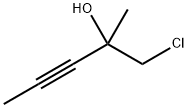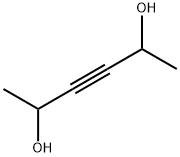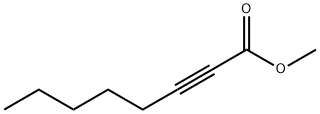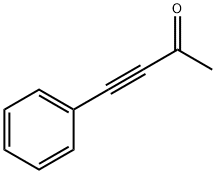2-PENTYNE
- CAS NO.:627-21-4
- Empirical Formula: C5H8
- Molecular Weight: 68.12
- MDL number: MFCD00009380
- EINECS: 210-989-2
- SAFETY DATA SHEET (SDS)
- Update Date: 2023-04-23 13:52:06

What is 2-PENTYNE?
Chemical properties
clear colorless to slightly yellow liquid
The Uses of 2-PENTYNE
2-Pentyne was used to test the catalytic activity of nanoparticles of palladium supported on bacterial biomass, bio-Pd.
Safety Profile
A very dangerous fire hazard when exposed to heat or flame; can react vigorously with oxidizing materials. Solutions with silver perchlorate explode on contact with mercury. When heated to decomposition it emits acrid smoke and irritating fumes.
Purification Methods
It is stood with, then distilled at low pressure from sodium or NaBH4. [Beilstein 1 III 958, 1 IV 992.]
Properties of 2-PENTYNE
| Melting point: | -109 °C (lit.) |
| Boiling point: | 56-57 °C (lit.) |
| Density | 0.71 g/mL at 25 °C (lit.) |
| vapor pressure | 393 mm Hg ( 37.7 °C) |
| refractive index | n |
| Flash point: | −23 °F |
| storage temp. | Flammables area |
| solubility | soluble in Ether,Alcohol,Benzene |
| form | Liquid |
| color | Clear colorless to slightly yellow |
| Specific Gravity | 0.711 |
| explosive limit | 1.2-8.8%(V) |
| BRN | 1696938 |
| CAS DataBase Reference | 627-21-4(CAS DataBase Reference) |
Safety information for 2-PENTYNE
| Signal word | Danger |
| Pictogram(s) |
 Flame Flammables GHS02  Exclamation Mark Irritant GHS07 |
| GHS Hazard Statements |
H225:Flammable liquids H315:Skin corrosion/irritation H319:Serious eye damage/eye irritation H335:Specific target organ toxicity, single exposure;Respiratory tract irritation |
| Precautionary Statement Codes |
P210:Keep away from heat/sparks/open flames/hot surfaces. — No smoking. P302+P352:IF ON SKIN: wash with plenty of soap and water. P305+P351+P338:IF IN EYES: Rinse cautiously with water for several minutes. Remove contact lenses, if present and easy to do. Continuerinsing. |
Computed Descriptors for 2-PENTYNE
New Products
Tert-butyl bis(2-chloroethyl)carbamate (S)-3-Aminobutanenitrile hydrochloride N-Boc-D-alaninol N-BOC-D/L-ALANINOL N-octanoyl benzotriazole 4-Hydrazinobenzoic acid 3,4-Dibenzyloxybenzaldehyde 3-Nitrobenzaldehyde 1,1’-CARBONYLDIIMIDAZOLE R-2-BENZYLOXY PROPIONIC ACID 1,1’-CARBONYLDI (1,2-4 TRIAZOLE) 4-HYDROXY BENZYL ALCOHOL 3-NITRO-2-METHYL ANILINE (2-Hydroxyphenyl)acetonitrile 5-BROMO-2CYANO PYRIDINE 5,6-Dimethoxyindanone 5-broMo-2-chloro-N-cyclopentylpyriMidin-4-aMine 2-(Cyanocyclohexyl)acetic acid 4-methoxy-3,5-dinitropyridine 2-aminopropyl benzoate hydrochloride 1-(4-(aminomethyl)benzyl)urea hydrochloride tert-butyl 4- (ureidomethyl)benzylcarbamate diethyl 2-(2-((tertbutoxycarbonyl)amino) ethyl)malonate Ethyl-2-chloro((4-methoxyphenyl)hydrazono)acetateRelated products of tetrahydrofuran








You may like
-
 2-Pentyne CAS 627-21-4View Details
2-Pentyne CAS 627-21-4View Details
627-21-4 -
 2-Pentyne CAS 627-21-4View Details
2-Pentyne CAS 627-21-4View Details
627-21-4 -
 2-Pentyne CAS 627-21-4View Details
2-Pentyne CAS 627-21-4View Details
627-21-4 -
 55441-95-7 99%View Details
55441-95-7 99%View Details
55441-95-7 -
 N-Vinylformamide 99%View Details
N-Vinylformamide 99%View Details
13162-05-5 -
 Chloro Uracil 1820-81-1 99%View Details
Chloro Uracil 1820-81-1 99%View Details
1820-81-1 -
 2-ethyl-6-methyl-3-hydroxypyridine succinate 99%View Details
2-ethyl-6-methyl-3-hydroxypyridine succinate 99%View Details
127464-43-1 -
 2-ETHYLPYRIDINE 100-71-0 99%View Details
2-ETHYLPYRIDINE 100-71-0 99%View Details
100-71-0
Statement: All products displayed on this website are only used for non medical purposes such as industrial applications or scientific research, and cannot be used for clinical diagnosis or treatment of humans or animals. They are not medicinal or edible.